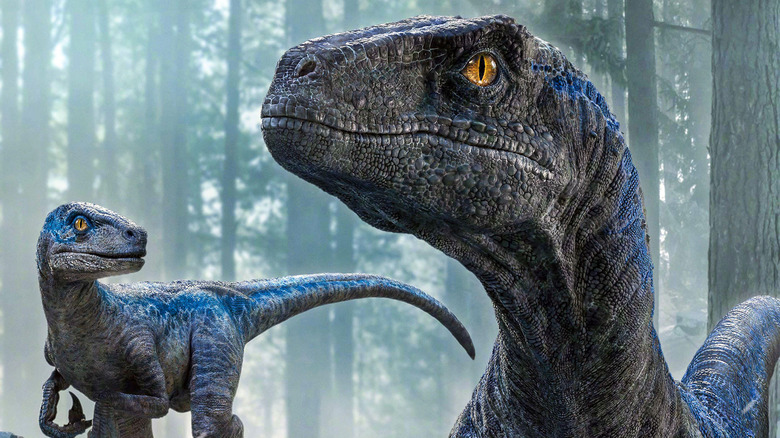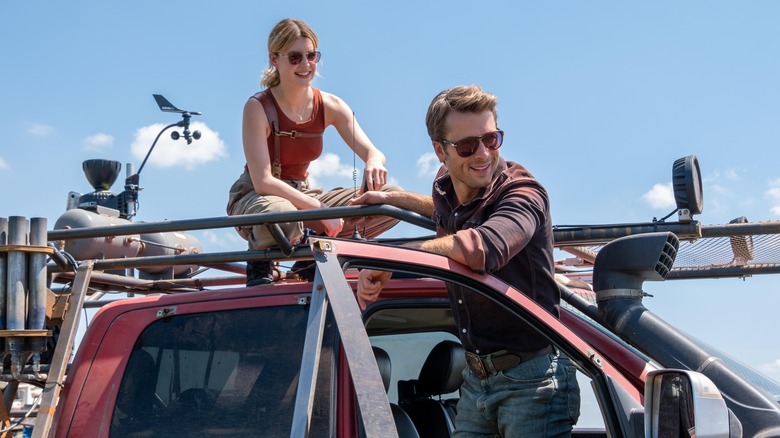Unlike The Dinos Of Jurassic World, Twisters Evolved With The Real Science Of Tornadoes
"Twisters," much like the original "Twister," isn't a realistic movie, but when it comes to the science behind the main character's plan to kill tornadoes in their tracks, it's at least trying to be believable. Kate's plan wouldn't work in real life, but it's based on a reasonable scientific understanding of how tornadoes operate, and it reflects the decades of extra research that's gone into tornadeos since the first movie came out.
"In the original 'Twister,' the idea of putting these Dorothy sensor balls into a tornado is completely science fiction, but it inspired a generation of people to want to do scientific research on storms," Director Lee Isaac Chung told The Hollywood Reporter. "With ["Twisters"], the endeavor that Kate [Daisy Edgar-Jones] is on to see if she can disrupt the dynamics of a tornado, this is also based on a lot of science fiction. We're just theorizing, and it's definitely not something we want people to be doing, but we wanted the film to pay homage to science and research and conducting very big ideas out there."
It's in step with how scientific understanding of tornadoes has evolved. "The amount of data available is amazing now compared to 30 years ago," said meteorologist Kevin Kelleher, who was consulted on both "Twister" films. That shift was reflected in the goals of the new movie's protagonists, who are less concerned with understanding tornadoes and more focused on stopping them. The technology the new movie uses to "collapse" tornadoes isn't real, writes one science journalist, but it's based on the real practice of "cloud seeding." The series' evolution is a step up from another franchise that began in the '90s, "Jurassic Park," which has often struggled to get with the times.
The Jurassic World films weren't just lazy with the characters
"People have been asking me again and again what I thought of the movie as a vertebrate paleontologist," wrote Donald Prothero in 2015 after "Jurassic World" came out. "My usual short answer is: 'A big disappointment: it's an OK monster movie, lousy science. And it could have been SO much better.'"
It's a common critique from anyone who studies dinosaurs, especially since the original "Jurassic Park" actually did put the effort in. "The original dinosaurs in the novel and the first movie reflected the latest research in dinosaurs. Instead of the sluggish, tail-dragging dumb lizards hanging out in swamps (as had been the image of dinosaurs for over a century), they were active, intelligent, with their tails held out behind them (not dragging on the ground)," Prothero wrote. "Jurassic Park" redefined the public perception of dinosaurs in a more accurate way, but the popularity of those dinosaurs became a trap for the franchise. "You couldn't really just change the design of the creatures midway through the franchise," visual effects supervisor David Vickery explained to Wired. "It would be a bit like replacing an actor with a completely different actor. Those designs are established."
Even though there'd been plenty of discoveries about dinosaurs in the past thirty years — most notably, that a lot of dinosaurs had feathers rather than smooth scaly skin — the new films chose to satisfy the audience's nostalgia for the first film rather than try to educate the public on any of this new information. "Paleontologists were horrified when Steven Spielberg and Colin Trevorrow decided not to update their science, but fell back on the old model of dinosaurs that is demonstrably wrong," wrote Prothero.
Chasing the science
"Twisters" is a widely-enjoyed sequel that embraced new changes in the scientific field in a million little ways. One notable minor choice was how the characters don't rate the tornadoes on the Fujita scale (using terms like "F1" and "F5") like they did in the first movie. Instead, they employ the Enhanced Fujita scale (saying "EF1" and "EF5"), which was first put to use in America back in 2007. This might not sound that impressive to anyone living in Tornado Alley, but it does show that the writers are prioritizing scientific accuracy over nostalgia points.
Meanwhile, most of the "Jurassic World" films clung to the inaccuracies of the first movie out of a misplaced idea that this is what viewers want. But as Prothero argued, maybe an updated, more accurate portrayal of dinosaurs is exactly what the series needed. "Some of the interviews suggest that the filmmakers once again made a decision that scaly dinosaurs are scary, feathered ones are not. But what better way to refresh a stale franchise than to give the dinosaurs a new look?" Prothero wrote. "I would submit that brightly feathered, eagle-eyed dinosaurs could be very scary."
As the more accurate portrayals of feathered dinosaurs in "Jurassic World: Dominion" later proved, Prothero was onto something. The feathers certainly didn't do any harm at the box office, so hopefully the upcoming "Jurassic World" reboot from director Gareth Edwards will embrace the most recent dinosaur research.


